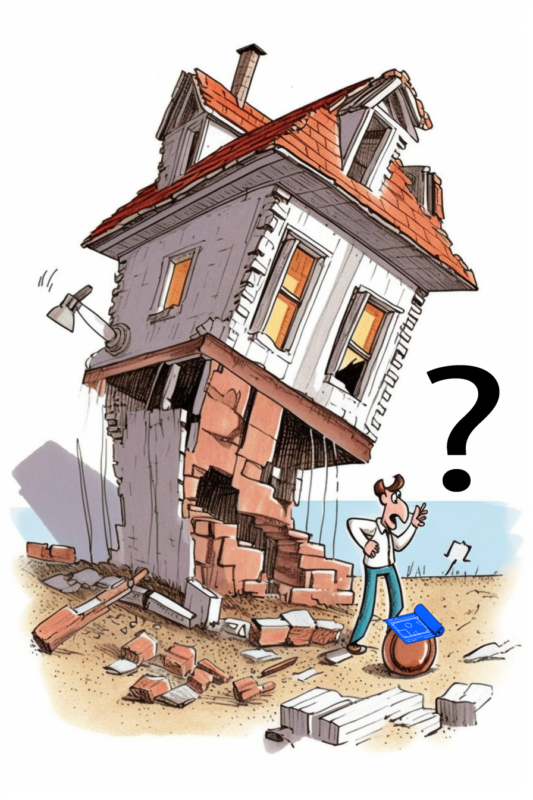Imagine that you’re building a house without a blueprint or a correctly figured project plan.
You start your construction work without a clear vision of the house layout, design, or any of the structural requirements.

As you proceed, you encounter one after another situation, causing the following steps to be impossible to start or continue due to previous efforts of unfinished work. In the worst case, the house may have its foundation unstable or lean from the other side. Eventually, hiding the facts as you proceed will only cause your walls or the house ceiling to crack during construction.
Without a Framework or Blueprint to guide you along the building process, the construction project becomes chaotic and prone to costly mistakes. This eventually ends up with the house project eventually being canceled or an endless journey of problems that cannot be bypassed without major fixes that cost time and effort.
We understand that we need a Framework, but how does this apply to the Solution Architect’s role?
Now, let’s apply this construction work analogy to Solution Architecture. A framework exists or is used to serve as the blueprint for designing and implementing an IT solution within an organization.
Here’s an example of how a framework leads the work:
Suppose a company wants to enhance its customer relationship management (CRM) system to streamline its processes and improve overall customer satisfaction. Here with a framework like TOGAF, the Solution Architect is given a structured approach that provides a common language, methodology, and tools to complete his/her work. Following this guideline, Solution Architect can now proceed with a step-by-step process to analyze the current CRM system, identify areas for improvement, define business requirements, design architectural solutions, and ensure alignment of the solution with the organization’s goals and strategies.
Applying this to our house construction example and for the role of Solution Architect, the role would consist of:
- Gathering Requirements: The Solution Architect engages with the homeowners to understand their needs, preferences, and budgetary constraints. They collect information about the desired layout, number of rooms, architectural style, and any specific requirements the homeowners may have, such as accessibility features or sustainable design elements.
- Designing the Blueprint: The Solution Architect creates a detailed blueprint for the house based on the gathered requirements. This blueprint includes the floor plan, room dimensions, structural elements, electrical and plumbing layouts, and any other specifications necessary for construction. The Solution Architect ensures the design aligns with building codes, zoning regulations, and safety standards.
- Collaborating with Stakeholders: The Solution Architect collaborates with various stakeholders involved in the construction process, such as builders, contractors, and engineers. They communicate the architectural vision, address any concerns or challenges, and coordinate the integration of different systems, such as heating, ventilation, air conditioning (HVAC), electrical, and plumbing, into the overall design.
- Evaluating Materials and Technologies: The Solution Architect stays up to date with the latest construction materials and technologies. They assess different options and make informed recommendations to the homeowners and construction team regarding the selection of materials, finishes, energy-efficient systems, and sustainable building practices.
- Overseeing Construction: During the construction phase, the Solution Architect serves as a liaison between the homeowners and the construction team. They monitor progress, ensure that the construction aligns with the approved blueprint, address any design-related issues that may arise, and make necessary adjustments to the plans as required.
- Quality Assurance: The Solution Architect conducts periodic site visits to ensure that the construction adheres to the architectural design and quality standards. They verify that the materials and workmanship meet the specifications, identify and address any deviations or deficiencies, and make recommendations for corrective actions if necessary.
- Project Completion: As the house nears completion, the Solution Architect performs a final walkthrough to verify that the construction matches the intended design. They collaborate with the homeowners to address any last-minute modifications or enhancements, ensuring that the finished house meets their expectations.

By fulfilling these roles, the Solution Architect plays a critical part in transforming the homeowners’ vision into a tangible and functional house. They combine their architectural expertise, technical knowledge, and attention to detail to create a well-designed and aesthetically pleasing living space that meets the homeowners’ needs and surpasses their expectations.
The framework not only brings consistency and standardization to the architectural process. It provides best practices from various industries, working templates, and guidelines for documenting and communicating the architecture, making it easier for stakeholders to understand and contribute to the solution.
With the help of a framework, a designed blueprint, and a passion for innovation, Solution Architects can guide the process, ensuring that every detail is meticulously planned and executed.
“We bridge the gap between imagination and reality, creating solutions where dreams find their perfect foundation.”
– Quote from a Solution Architect
Revolutionize your business with AI and solution architecture frameworks.
Our Solution Architects ensure seamless planning and execution, transforming your vision into reality. Embrace innovation and unlock success.
Contact us now to get started.

Great article on solution architecture! The detailed explanation complements the insights shared in https://www.cleveroad.com/blog/what-does-a-solutions-architect-do/. Your discussion on the importance of aligning IT strategy with business goals is particularly valuable.
Appreciate your comment Olivia! Yes, this aligns much alike with your post over the SA role.